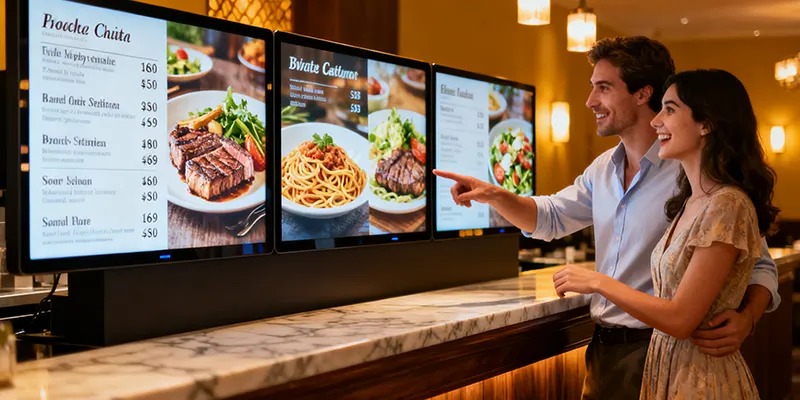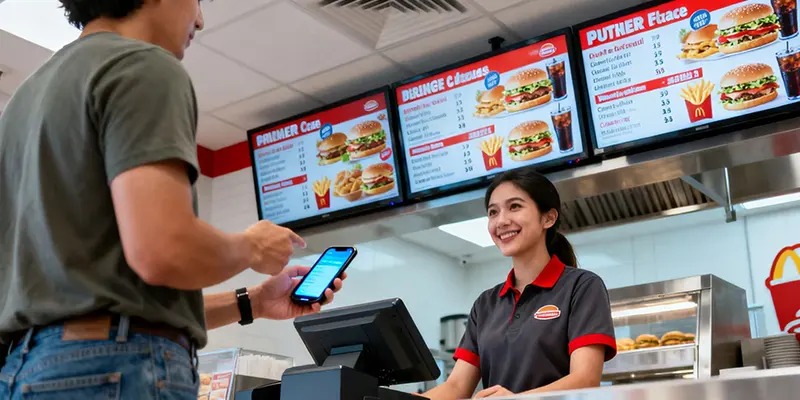What is a Digital Menu Player?
A Digital Menu Player is a modern, electronic display used by restaurants to show their menus digitally. Instead of traditional paper menus, these screens present menu items, prices, and descriptions in a dynamic and visually appealing way. Digital menu players can be interactive, allowing customers to browse the menu, view detailed information, and even place orders directly from the screen. They are commonly used in restaurants, cafes, bars, and fast food outlets to improve customer experience, streamline operations, and reduce the need for paper menus. These systems can also integrate with POS systems for real-time updates and better inventory management.
1. Why are Digital Menu Players Becoming Popular?
Enhanced Customer Experience: Digital menus provide a modern and interactive way for customers to explore food and drink options. They can easily navigate through the menu, view images, read detailed descriptions, and make customizations. This not only makes the ordering process more engaging but also helps customers make quicker, informed decisions.
Real-Time Updates: Unlike traditional paper menus, digital menus can be updated instantly. If a dish runs out, prices change, or there’s a special promotion, restaurant owners can make adjustments in real-time without the need to print new menus. This flexibility helps businesses stay dynamic and responsive to changing needs.
Cost Efficiency: While digital menu players require an initial investment, they eliminate the recurring costs of printing and replacing paper menus. Over time, this leads to significant savings for businesses, especially those with large menus or frequent changes.
2. The Evolution of Menus in Restaurants
Traditional Paper Menus: For many years, restaurants used paper menus, which were easy to print but required frequent updates and were prone to wear and tear.
Shift to Digital Menus: With the advancement of technology, digital menus emerged, offering greater flexibility. Restaurants could update items and prices in real-time without needing to print new menus.
Interactive Touchscreen Menus: Digital menus became more interactive, allowing customers to browse items, customize orders, and even pay directly from the screen.
3. How Does a Digital Menu Player Work?
Display Content: The system shows menu items, prices, and descriptions on a screen. It can also include images, videos, and promotional content.
Interactive Features: Many digital menu players are touch-enabled, allowing customers to browse through categories, view detailed information, and even customize their orders.
Integration with POS Systems: Digital menu players are often connected to the restaurant’s Point of Sale (POS) system, ensuring that menu items and prices are always up-to-date.
Real-Time Updates: Changes to the menu (e.g., adding new dishes or updating prices) can be made instantly, reducing the need for printed materials.
4. Key Features of a Digital Menu Player
Customizable Displays: Digital menu players allow restaurants to adjust the layout, colors, fonts, and images to match their brand identity.
Interactive Options: Many systems are touch-enabled, enabling customers to browse the menu, view item details, and customize their orders.Integration with POS Systems: These players connect with the restaurant's Point of Sale (POS) system, allowing for real-time updates of menu items, prices, and availability.
Real-Time Updates: Changes to the menu, such as removing items or updating prices, can be done instantly without needing to reprint physical menus.
Multimedia Content: Digital menu players can display images, videos, and special promotions, enhancing the customer experience.
5. Benefits of Using a Digital Menu Player
Improved Customer Experience: Digital menus are interactive and visually engaging, helping customers make quicker, informed decisions.
Cost Savings: By eliminating the need for printed menus, restaurants save on printing costs and reduce waste.
Real-Time Updates: Menu changes, such as price updates or new items, can be made instantly, ensuring accuracy and efficiency.
Enhanced Branding: Customizable displays allow restaurants to showcase their brand identity with tailored visuals and content.
Streamlined Operations: Integration with POS systems improves efficiency by automatically syncing menu updates, reducing errors and labor costs.
6. How to Choose the Right Digital Menu Player for Your Business Conclusion
Restaurant Size: Larger restaurants may need wall-mounted screens, while smaller ones could benefit from tabletop or app-based solutions.
Ease of Use: Choose a system that’s easy for both staff and customers to operate with minimal training.
Integration: Ensure the system integrates seamlessly with your POS and other restaurant management tools.
Budget: Consider both the initial investment and long-term savings. The right system should offer good ROI.
Customization Options: Look for flexibility in design and functionality to match your brand and menu style.
Conclusion
A Digital Menu Player is an electronic display used by restaurants to show their menus digitally. It replaces traditional paper menus and offers features like real-time updates, interactive browsing, and integration with POS systems. These systems improve customer experience, streamline operations, and reduce costs by allowing easy menu changes and customization.
FAQs
1. What is the cost of a digital menu player?
The cost of a digital menu player can vary depending on the system's features and the size of your restaurant. Prices typically range from a few hundred to several thousand dollars. Factors such as screen size, software customization, and integration with POS systems can affect the overall price.
2. Can I use a digital menu player in a small restaurant?
Yes, digital menu players can be used in small restaurants. In fact, tabletop or mobile solutions are ideal for smaller spaces, providing a modern, interactive experience without the need for large displays.
3. How often do digital menu players need to be updated?
Digital menu players can be updated as often as needed. Menu items, prices, and promotions can be changed in real-time, ensuring the information is always accurate without the need for printing new menus.
4. Are digital menu players easy to set up?
Yes, most digital menu players are designed to be user-friendly and easy to set up. Many systems come with detailed instructions or customer support to assist with installation and integration into your existing restaurant operations.


